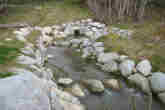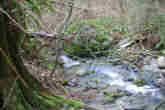Turners Creek Watershed
Profile
Characteristics
- 11th largest watershed in Port Moody (out of 16: Robertson Env. 2000).
- Discharges into the Port Moody Arm of Burrard Inlet.
- Bordered to the east by the Hutchinson Creek and Noons Creek watersheds, to the west by the Wilkes Creek watershed, to the north by the Village of Anmore, and to the south by Burrard Inlet. A small portion of the watershed lies within Village of Anmore boundaries.
- Effective catchment area has increased from 120.3 ha to 126.6 ha by stormwater drainage from developed areas in adjacent watersheds (GVRD 1999).
- Average annual watershed precipitation is 1970 mm (GVRD 1999).
- Average annual watershed flow is 1501 mm, with an additional 793 mm from stormwater runoff. When the entire catchment is considered, including diversions from neighbouring watersheds, stormwater runoff increases to 800 mm (GVRD 1999).
- In 1996 21.0% of the watershed was developed and impervious to water, with 80% of the riparian forest intact. The 1996 GVS&DD watershed classification was 'Good' (GVS&DD 1999).
- In general, the area encompassed by this watershed lies on significant, south-southwest facing slopes with deep, nutrient-rich soils.
- Turners Creek is 2.8 km long. Historically, two branches, East Turners Creek and West Turners Creek, originated as sidehill runoff on the south slopes of Eagle Mountain: East Turners is scheduled to be enclosed in stormsewers underneath new development. The two streams flow south-southwest to their confluence between Ravine Drive and Heritage Mountain Boulevard, forming Turners Creek. Turner's Creek continues flowing south-southwest for approximately 1 km before entering the Port Moody Arm of Burrard Inlet. In general the stream has a steep gradient characterized by stable streambeds with boulder and cobble substrate
History
- This area was logged between 1920-1940 following completion of the "Climax" high-grade locomotive and railway (City of Port Moody website).
- Coastal Cutthroat Troat (Onchorhynchus clarki clarki) and Coho (Onchorhynchus kisutch) inhabited the lower section of Turners Creek until the early 1970's when major stream alterations rendered the stream uninhabitable (Dunster and AXYS 1999).
- Industrial activities have polluted the marine environment of Port Moody Arm into which Turners Creek flows, leading Environment Canada to identify this area as an "environmental hotspot" in 1992 (Dunster and AXYS 1999). These pollutants include the metals cadmium, chromium, copper, lead, and zinc (originating from metal coating, plastic stabilizers, paint pigments, and, to a lesser extent, pesticides and sewage), as well as organic compounds like oil and grease hydrocarbons and polycylic aromatic hydrocarbons (originating from petroleum facilities). Polychlorinated biphenyls (PCBs, used to produce plastics, inks, paints and pesticides but banned since the mid-1970s) persist in low concentrations throughout Port Moody Arm. In 1987, all of these pollutants occured in the highest concentrations near the Ioco refinery, decreasing in concentration towards Indian Arm and the Port Moody tidal flats (Environment Canada 1989).
- The upper section of the watershed was recommended for designation as an environmentally sensitive area in 2000 (Robertson 2000).
- As compensation for the loss of stream habitat at the Heritage Mountain Boulevard and David Avenue right of ways, 60 meters of Turners Creek was 'daylighted' at the stream mouth in 2002. Concrete culvert was removed from the stream mouth at Burrard Inlet to the Shoreline Park bike path and a new stream channel was constructed so that it would connect to standing water in a drainage ditch in Shoreline Park. This compensation project has added 125 m2 of stream channel habitat and 1000 m2 of riparian forest, as well as providing for fish access to an additional 250 m2 of off-channel habitat (Jacques Whitford 2001).
Watershed Use
- Residential: predominantly single-family residential houses with some condominiums.
- Institutional: a portion of the upper headwaters area has been set aside by the City of Port Moody as a"future community park and secondary school". Site clearing for school construction began in 2002.
- Parks and recreation: Turners Creek Ravine, Old Mill Park, and a portion of the North Shore Escarpment are all within this watershed.
- CP Rail has a right-of-way near the stream mouth.
- BC Hydro has a powerline right-of-way that crosses through the upper end of the watershed.
- Fish: A fish sampling program performed for the City of Port Moody in December of 2000 (Jacques Whitford 2001) failed to find fish, but prickly sculpin (Cottus asper) may inhabit this stream. Habitat enhancement work at the stream mouth may facilitate the return of salmonids and three-spined stickleback (Gasterosteus aculeatus). An adult coho (Onchorhynchus kisutch), probably a stray from nearby Mossom, Hutchinson, or Noons Creek, was observed in the newly constructed channel in December 2002 (PMES observation).
- Wildlife: coyote, black bear, cougar, bobcat, mule deer, Douglas squirrel, red-back vole, deer mouse, Northwestern salamander and Pacific tree frog are among the more prominent terrestrial animals (Dunster and AXYS 1999).
- Birds: a diverse bird assemblage includes several species of woodpeckers and raptors, American dipper, and, near the mouth of Turners Creek, shorebirds, waterfowl, and blue heron (Dunster and AXY 1999, Jacques Whitford 2001). Historically, 131 bird species are known to inhabit the Port Moody area (Burke Mountain Naturalists 1994)
- Vegetation: Presently a secondary growth forest ranging in age from 60-80 years. Trees are a mix of western hemlock (Tsuga heterophylla), Douglas fir (Pseudotsuga menziesii), western red cedar (Thuja plicata), red alder (Alnus rubra), broad-leaf maple (Acer macrophyllum) and vine maple (Acer corcinatum). The understory is predominantly salmonberry (Rubus spectabilis), blackberrty (Rubus ursinus), sword fern (Polystichum munitum), spiny wood fern (Dryopteris expansa) and huckleberry (Vaccinium spp.). A diverse assemblage of species associated with wetlands exists in the upper portion of the watershed. Several plant communities are present which are of special concern (see below) (Dunster and AXYS 1999).
Concerns
- Culverting: although the first 60 meters of the stream mouth has been 'daylighted', several fish barriers exist. Ten culvert road crossings exist on the Turners system. West Turners Creek is culverted at Ravine Drive, Aspenwood Drive and David Avenue. East Turners Creek is culverted at David Avenue, Ravine Drive, and is scheduled to be enclosed into storm sewers upstream of Forest Parkway. The mainstem of Turners Creek has been culverted at Heritage Mountain Boulevard, Parkside Drive, and from Ioco Road to below the CP Rail right of way. None of these culverts are passable by salmonids. These along with other major stream alterations (rip-rap armoring, gabion banks, channelisation, storm sewer drainage) have rendered Turners Creek upstream of the CP Rail right of way uninhabitable to salmonids. Development beginning in 2001 will eventually enclose the headwaters of West Turners Creek and an unnamed tributary above Forest Parkway. This is predicted to cause the permanent loss of approximately 14,700 m2 of riparian habitat and approximately 425 m2 of in stream habitat (City of Port Moody 2001).
- Stormwater: The developed area of the watershed is predicted to increase from its 1996 level of 21.0% to 59.0% by 2036. This is predicted to increase average annual watershed flow from 1501 mm to 1647 mm (GVRD 1999). More importantly, average annual stormwater runoff is predicted to increase from 793 mm to 1265 mm (GVRD 1999). Port Moody Neighbourhood 2 (above Panorama Drive) is currently being developed with a stormwater drainage system incorporating a 3-way manhole splitter. This will direct the "first flush" of stormwater from Neighbourhood 2 (containing the majority of oil and sediments) to East Turners Creek at David Avenue. The majority of additional flow will be diverted to West Noons Creek, with East Turners Creek receiving additional flow only during extreme runoff events (City of Port Moody 2001). The predicted GVS&DD watershed classification falls from 'Good' to 'Poor' in 2036 as the increase in the relative contribution of stormwater to Turners Creek will introduce water quality issues, especially with the diversion of first flush stormwater from Neighbourhood 2 (GVS&DD 1999).
- Plant communities of concern: the Western hemlock-flat moss, the Douglas fir / Western hemlock-salal, and the Western red cedar-sword fern commounities are present in this watershed and are provincially blue-listed (of special concern), while the Douglas fir-sword fern and the Western red cedar-salmonberry communities are also present and are provincially red-listed (endangered) (Robertson 2000).
- Animal species of concern: Great blue herons are provincially blue-listed (of special concern) (Dunster and AXYS 1999)
- Construction of Secondary School above David Avenue could cause sedimentation problems, although the City of Port Moody's required 15 metre building set-back from the stream should help to alleviate this (City of Port Moody Planning Department 1992).
Key Interest Groups
- Municipal Government: City of Port Moody, Village of Anmore
- Regional: GVRD and GVS&DD
- Provincial Government: Ministry of Transportation and Highways; Ministry of Environment, Lands and Parks; Burrard Inlet Environmental Action Program
- Federal Government: Fisheries and Oceans Canada, Environment Canada, Transport Canada
- Local NGO's: Port Moody Ecological Society
- BC Rail
- BC Hydro
- Various private landowners and occupants
- School District #43
Watershed Projects
- Ongoing water quality and fecal coliform monitoring by Port Moody Ecological Society.
Bibliography and Available Sources of Information
- Port Moody Public Library. 604 469 4577.
- Port Moody Ecological Society Library. 604 469 9106.
- City of Port Moody Environmental Services. 604 469 4676
- City of Port Moody website. http://www.cityofportmoody.com/
- Burke Mountain Naturalists. 1994. Wildlife Inventory of the Shoreline Park System, Port Moody, BC. Prepared for the City of Port Moody and the Burrard Inlet Environmental Action Program.
- City of Port Moody Planning Department. 1992. Summary of the Proposed New Official Community Plan for Port Moody. Prepared by the Community Planning Advisory Committee.
- City of Port Moody. 2001. Ammended Neigbourhood 2 Plan. Available at Port Moody City Hall.
- Dunster and Associates Environmental Consultants Ltd., and AXYS Environmental Consulting Ltd. 1999. City of Port Moody Environmentally Sensitive Areas Management Strategy. Phase 1: An Inventory of Natural Areas. Prepared for the City of Port Moody.
- Environment Canada. 1989. Distribution and Environmental Impact of Selected Benthic Contaminants in Vancouver Harbour, British Columbia: 1985-1987. Pacific and Yukon Region Program Report 89-02.
- Greater Vancouver Regional District. 1999. Watershed flows and stormwater runoff: estimates for 1996 & 2036. http://www.gvrd.bc.ca/services/sewers/drain/Reports/stormwater_rpts_1997-2002/runoff/estimates.pdf
- Greater Vancouver Sewerage and Drainage District. 1999. Assessment of Current and Futrure GVS&DD Area Watersged and Catchment Conditions.
- Jacques Whitford Environment Ltd. 2001. Application for Environmental Review: North Shore Arterial Roads David Avenue and Heritage Mountain Boulevard, Port Moody, BC. Unpublished Report Prepared for the City of Port Moody.
- Robertson Environmental Services Ltd. 2000. City of Port Moody Environmentally Sensitive Areas Management Strategy. Phase 2: Development of Management Recommendations. Prepared for the City of Port Moody.

